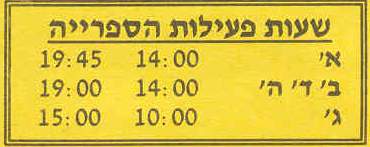
Roman letters represent numbers, their I = 1, their V = 5, X =10, etc. Likewise with Hebrew! Alef = 1, Bet = 2, Gimel=3, Dalet =4, Hay = 5, Vav = 6, Zayin =7, Het = 8, Tet =9, Yod = 10, Kaf = 20, Lamed = 30, Mem = 40, Nun = 50, Sameh = 60, Ayin = 70, Pay = 80, Tzadee = 90, Kof = 100, Resh =200, Shin = 300, and Tav = 400 (red outline).
Also letters are used for abbreviating the days of the week. Shabbat (Saturday/Alef) is day one. Sunday/Bet is day two. Monday/Gimel-day three. Tuesday/Dalet-day four. Wednesday/Hay-day five. Thursday/Vav-day six. And Sunday/Zayin-day seven.
So in the yellow box below, reading from right to left: Sat. 2 P.M. to 7:45 P.M.; Sun., Tue., Wen. 2 P.M. to 7.P.M.; and Mon. 10 A.M. to 3 P.M.

Oh yah, the apostrophe after the Hebrew letter (remember weíre reading right to left) lets you know that itís an abbreviation. Similar as in words like: donít, canít, itís, and so on.
Also the time is written sort of like military time. A day has 24 hrs and thatís how they write it. 0800 is 8 A.M, 1000 is 10 A.M., 1200 is 12 noon, 1300 is 1 P.M., and 1400 is 2 P.M. etc. The morning hours are pretty straight forward. The afternoon hours can be quickly computed by subtracting 12. Thus 1400, lets say 14 Ė 12 = 2 P.M., 19:45 Ė 12 = 7:45 P.M., 2400 hours (24 - 12) is midnight.
I hope some of this makes sense? I almost got myself confused.
P.S. In my Bible (see slide 2) the Ten Commandments are numbered Alef to Yod. (blue outline).
Edwin Beckford